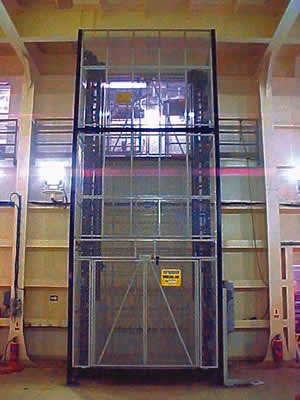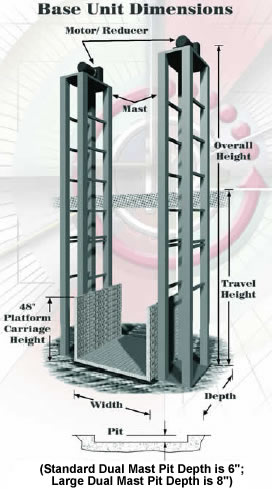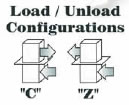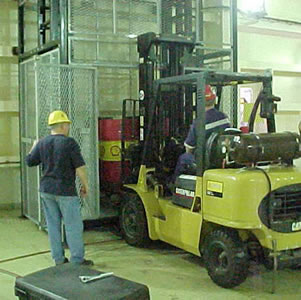|
DUAL
MAST MEZZANINE LIFT
|
|
VRC
|
|
Dual Mast Mezzanine Lift (Vertical Reciprocating Conveyor) provides
extra strength for heavy loads up to 12,000 pounds and offers
a variety
of larger platform carriage sizes up to 12' x 12'. This lift
is great when
overhead space is limited because it only requires 7'2"
of height above
the upper level. Also, it can be loaded and unloaded from the
front or
the rear. |
 |
|
|
|
|
| Made
Especially For... |
|
Warehousing/Storage
Facilities, Manufacturing Facilities, Paper and
Textile Industries, Aerospace Industry, Military Bases, Ships
and
Marine Vessels to name a few. |
|
|
|
|
| Standard
Features... |
|
|
•
Travel Height: Up to 90'
• Operating Speed: 30 fpm
• Power Requirement: 230v 3-phase 60 hertz
• Operator controls at each level
• Upper and Lower Travel Limit Switches
• Fail-Safe Brake Motors
• Chain Safety Brakes
• Slack Chain Switches
• Soft Start/Soft Stop Operation
• Mount: Surface or Pit |
|
|
|
|
|
|
For
Heavy Loads In Height
Restricted Areas
|
|
|
|
|
|
|
|
|
|
|
 |
|
|
|
|
|
Options
|
 |
|
Technical
Specifications |
Operating
Speed Increased
Power - 460v 3-phase 60 hertz Ground Level Loading Ramp
Security Enclosures
Gates with Electro -
Mechanical Interlocks
Multi - Level Operation
Special Environments |
|
Technical
Specifications for the Dual
Mast Mezzanine Lift are shown below.
Please fill in your desired specifications
in the spaces provided. Contact us for
special requirements or configurations.
|
|
|
|
1.
What weight capacity do you require?
(1,000 - 12,000 lbs.) _____________ |
|
2.
What is the height in inches from the
ground level floor surface to the
second level floor surface?
(Up to 90') __________________ |
|
|
|
Platform
Carriage Side
Rails Enclosures
|
|
3.
Platform carriage size:
4' - 12' (w) x 4' - 12' (d) ___________ |
|
4. What
platform load height do you
require? 72"(h) standard; 78"(h)
max.
through doors. _______________
|
|
48"(h)
on non-access openings,
snap chains on access ends
|
|
|
5.
Which load / unload configuration
do you require? ____ C _____Z |
|
|
 |
|
|
6.
How will the unit be mounted?
___surface ___ pit |
|
|
|
Surface
Mount: |
|
The
loading height is 6"-8" from the floor
on the ground level and flush with the
floor on the upper levels. |
|
|
|
|
|
|
|
Pit
Mount: |
|
|
Loading
height is flush with the floor on
all levels. (Standard Dual Mast Pit Depth
is 6" - 8".) |
|
|
|
| Note: |
|
|
|
Our
mezzanine lifts are manufactured to ANSI/ASME B20.1 safety standards.
They are not subject to elevator codes as they are
designed for material lifting only. No personnel are permitted
to ride on any mezzanine lift. The following items are to be
supplied by
others and are not included with the mezzanine lift: (1) Wall
and floor hardware to secure the lift to the walls and floor,
(2) External
electrical wiring which is to be performed by a qualified electrician
to local and national codes, (3) Conduit and disconnect switch
that is required to connect to our control panel, (4) Upper
and lower thresholds. |
|
|
|
|
|
 |
|
 |
|
|
|
Illustrated
As A 2-Level Lift with
Optional Security Enclosures;
Multi-Level Versions are Available |
|
|
|
|
|
|
ARCHITECTURAL
SPECIFICATIONS
VERTICAL RECIPROCATING CONVEYOR
|
|
|
|
|
|
| PART
1: GENERAL |
|
|
|
|
|
|
| 1.01:
OVERVIEW |
|
|
A. Design and manufacturing of one (1) dual mast type Vertical
Reciprocating Conveyor (VRC) including
mechanical drive unit, operator controls,
safety gates and enclosures as shown on project drawings and
as specified herein. |
|
|
|
|
|
| 1.02:
REFERENCES |
|
|
|
|
|
|
|
|
A.
ANSI - American National Standards Institute (ANSI B20.1) |
|
B.
ASME - American Society of Mechanical Engineers (ASME B20.1) |
|
C.
NEMA - National Electrical Manufacturer's Association |
|
|
|
|
|
| 1.03:
SUBMITTALS |
|
|
|
|
|
|
|
|
A.
Product Data: Submit latest edition of Dual Mast VRC datasheet
and general drawings with the proposal. |
|
|
|
|
|
|
B.
Customer Drawings: |
|
|
|
|
|
|
|
1.
Submit Customer Engineering Drawings for customer approval within
2 weeks after receipt of an order to
include plans, elevations, sections of the VRC, base plate and
lateral loading values, and recommended pit
dimensions if applicable. |
|
|
|
|
|
|
|
2.
Submit VRC Specification Sheet for approval within two weeks
of receipt of an order to include scope
of work, operating and control voltages, lift speed, type of
finish, and any special project notes. |
|
|
|
|
|
|
C.
Closeout Submittals provided with VRC Equipment: |
|
|
|
|
|
|
|
1.
Electrical Schematics Drawing including control panel layout
and Bill of Material reflecting original
manufactured part numbers. |
|
|
2.
Mechanical Installation Manual and Electrical Installation Guide. |
|
|
3.
Digital Control Panel trouble shooting guide. |
|
|
4.
Owner's Manual including replacement parts list, exploded parts
drawings, operating instructions,
maintenance schedule, and service and troubleshooting guidelines. |
|
|
|
|
|
| 1.04:
QUALITY ASSURANCE |
|
|
|
|
|
|
|
|
A.
Manufacturer must have a minimum of five (5) years experience
in the manufacturing of vertical
reciprocating conveyors. |
|
B.
Vertical Reciprocating Conveyors (VRC) are covered by ANSI/ASME
B20.1 Safety Standards for Conveyors.
We have thousands of vertical lifts installed throughout the
country and in surrounding countries. NO VRC has ever
been shut down due to lack of elevator code compliance. |
|
C.
Installer must have the approval of FSI and have a minimum of
five (5) years experience in the installation
of vertical material lifts. |
|
|
|
|
|
| 1.05:
WARRANTY |
|
|
|
|
|
|
|
|
A.
The manufacturer shall warrant the VRC against manufacturing
defects from date of installation as outlined
below: |
|
|
|
|
|
|
|
1.
Electric Motor and Cyclo-Drive Reducer - two (2) years. |
|
|
2.
Electrical Components - ninety (90) days. |
|
|
3.
Mechanical Components - one (1) year. |
|
|
|
|
|
| PART
2: PRODUCTS |
|
|
|
|
|
|
|
2.01:
VRC MECHANICAL SPECIFICATIONS |
|
|
|
|
|
|
|
A.
Load Capacity: The VRC shall be rated at a live load capacity
of _______ lbs. |
|
|
B.
Operating Speed: The VRC shall have a vertical lifting speed
of 20 - 25 feet per minute when loaded to
maximum capacity. |
|
|
C.
Vertical Travel Height: The VRC shall have a vertical lifting
height of _____ inches with a total of _____
landings (including lowest level) with a distance between floors
of ______ inches. |
|
|
D.
Lift Carriage: The VRC carriage shall be a minimum of _____
inches wide x _____ inches deep
with a steel deck plate and minimum of 48" high welded
or bolt-on side panels on all non-operating ends
and safety chains with snap hooks on all operating ends. |
|
|
E.
Vertical Masts: The VRC shall have a two (2) support mast constructed
of four (4) 4" square structural grade
steel tubes for vertical support and strengthened by horizontal
2" square steel tubes. |
|
|
F.
Deflection Under Load: No portion of the VRC shall exhibit permanent
deflection when loaded to full capacity. |
|
|
G.
Shock Load: The VRC must be able to withstand a shock load of
at least 500% to ensure safety. |
|
|
H.
Lifting Means: The drive system shall be comprised of four (4)
sprockets transmitting lifting forces through
four (4) chains to the back section of the carriage. The electrical
drive motors shall be 100% duty cycle coupled
with a Cyclo-Drive gear reducer with a shock load rating of
500%. Planetary or helical gear reducers are not
allowed. |
|
|
I.
Safety Brakes and Devices: The Carriage shall be equipped with
one (2) broken/slack chain brake that
prevents the carriage from descending more than 6" if tension
is lost on either chain. Slack chain switches are
required to disable motor power in the event a chain becomes
slack or broken. |
|
|
J.
Security Enclosures: Guarding on all non-operating sides of
the VRC shall be by security enclosures extending
a minimum of 8' high at each level consisting of expanded metal
which will reject a ½" diameter ball. Security
enclosures shall tie directly into the vertical mast for added
structural support. |
|
|
K.
Landing Gates: Gates are required on all operating sides of
the VRC at each level of operation. |
|
|
|
1.
The gates shall be (double swing) (vertical slide) (horizontal
slide) (roll-up) type. |
|
|
|
2.
Each gate must be equipped with an elevator approved electro-mechanical
interlock to prevent opening
of the gate unless the carriage is present and to prevent operation
unless all gates are closed. |
|
|
L.
Signage: Signs dictating "NO RIDERS" and maximum weight
capacity shall be placed at every access point
and visible from all operating ends of the carriage. |
|
|
M.
Approach Ramp: If pit mounting is not specified, the manufacturer
shall supply a steel fabricated 8" high
approach ramp to be installed within ½" of the VRC
carriage at the ground level. |
|
|
N.
Power Requirements: The VRC shall be manufactured to operate
on 230 volts / 3 phase / 60 hertz power.
Controls voltage must be no greater than 24 volts. |
|
|
O.
Load Pattern: The pattern for loading and unloading the carriage
at different levels must be a "Z" or "C"
configuration. |
|
|
|
|
|
| 2.03:
VRC ELECTRICAL SPECIFICATIONS |
|
|
|
|
|
|
|
|
|
|
|
|
|
A.
Electric Motor: |
|
|
|
|
|
|
|
|
|
|
|
|
|
|
1. Each of two (2) motors shall have a minimum duty cycle of
100%. |
|
|
|
2.
Each motor and Cyclo-Drive gear reducer must be able to withstand
a shock load of at least 500% to ensure
safety. |
|
|
|
3. Motor horsepower shall be sized to handle the carriage weight
in addition to the rated live load and
specified speed. |
|
|
|
4.
All motors are three phase and shall be designed for continuous
duty at ambient temperatures for 32° to 102°
Fahrenheit |
|
|
|
5.
The motors shall not automatically restart when the overload
device is reset. |
|
|
|
6.
Each motor shall be equipped with a heavy-duty, long life, fast-acting
fail-safe disc brake to ensure the brake
will hold in case of power failure. |
|
|
|
|
|
|
|
|
|
|
|
|
B.
Controls: |
|
|
|
|
|
|
|
|
|
|
|
|
|
|
|
|
|
|
|
1.
Each operating floor shall be equipped with a momentary contact
push-button control station with full call,
send and mushroom style E-stop switches for manual control of
lift operation. |
|
|
|
2.
An internally pre-wired, NEMA 12 rated Intelitroll self-diagnostic
control panel shall be provided with
appropriate transformer, overload relay, phase monitor device,
field wiring terminal block and breakers. |
|
|
|
3.
Limit Switches: The VRC shall be equipped with a floor level
switch at each level, upper level, and over
travel limit switch to provide precise positioning of the carriage. |
|
|
|
4.
Slack Chain Safety Switches: Two switches shall be provided
to monitor slack chain situations and disable
power to the motor while engaging carriage safety brakes in
the event of a slack or broken chain. |
|
|
|
5. The control voltage shall not exceed 24 volts for safety
reasons. |
|
|
|
|
|
|
|
|
|
|
|
|
C.
Power Source: Owner shall terminate high voltage operating power
within 10 feet of the location designated
for the VRC installation. |
|
|
|
|
|
|
|
|
|
|
| 2.04:
FINISHES |
|
|
|
|
|
|
|
|
|
|
|
|
|
|
|
|
A.
All carbon steel surfaces shall be coated with an industrial
enamel finish - color slate gray and black. |
|
|
B.
Prior to applying finish, all dirt, mill scale, oil and grease
shall be removed from carbon steel surfaces
by a combination of brushing, wiping and use of solvents. |
|
|
|
|
|
|
|
|
|
|
|
PART
3: EXECUTION |
|
|
|
|
|
|
|
|
|
|
|
|
|
|
|
|
3.01:
EXAMINATION |
|
|
|
|
|
|
|
A.
Prior to commencing installation of the VRC, the installer shall
visually examine the conditions under which
the VRC is to be installed and notify the architect in writing
of conditions detrimental to the proper and timely
completion of the work. |
|
|
|
|
|
|
|
|
|
|
|
3.02:
INSTALLATION |
|
|
|
|
|
|
|
|
|
|
|
|
|
|
|
|
|
|
A.
Installer must comply with manufacturer's detailed mechanical
and electrical installation instructions for proper
installation and to meet safety codes. All thresholds and extra
installation materials needed must be supplied
by the installer. |
|
|
|
|
|
|
|
|
|
|
| 3.03:
FIELD QUALITY CONTROL |
|
|
|
|
|
A.
Inspection: Upon completion of installation, the VRC shall be
inspected to verify that it meets all
requirements set forth by FSI and Parts 1, 2 and 3 of this Section. |
|
|
|
|
|
|
|
|
|
|
|
|
B.
Tests: |
|
|
|
1.
Operating Load Test: The owner will provide a _______ pound
test load and load the VRC at the lowest
level. The loaded VRC carriage shall be conveyed to an upper
floor level and returned to the lowest level to
assure proper operation. If the VRC cannot lift or lower the
load, the VRC shall fail the test. |
|
|
|
2.
Performance Test: This test is to be performed in conjunction
with Test 1 above. During the demonstration
of the lifting and lowering test, the owner shall measure the
time required to lift and lower the capacity load.
The owner will average times for lifting and lowering the load
and calculate the average feet per minute travel
speed. If the VRC does not lift the load within 10% of the specified
speed, or if the lowering speed exceeds
the lifting speed by more than 10%, the VRC shall fail the test. |
|
|
|
3.
Stationary Load Test: This test is to be performed in conjunction
with Test 1 above. The loaded VRC
carriage shall remain stationary at an upper level for a minimum
of one (1) hour. After the one (1) hour period,
the VRC will be inspected for deflection of the components or
drift of the platform. If deformation or downward
drift is evident, the VRC shall fail the test. |
|
|
|
|
|
|
|
|
|
|
|
3.04:
ADJUSTING AND CLEANUP |
|
|
|
|
A.
Installer shall touch up all scratches, abrasions, and other
defects in the pre-finished surfaces with the same
material color and type of finish as that used at time of fabrication. |
|
|
B.
Installer will remove and dispose of all rubbish and debris
caused by the work under this section. |
|
|
C.
Verification that equipment is properly installed in accordance
with manufacturer's guidelines and guarded to
meet or exceed ANSI/ASME B20.1 Safety Standards for Conveyors. |
|
Dual
Mast Mezzanine Lift, Mezzanine Material Lifts, Custom Industrial
Material Lift, Vertical Conveyor, Freight Elevator,
Vertical Material Lifts, Vertical Platform Lifts, Vertical Reciprocating
Conveyor, Pallet Master, and VRC form your
source for material handling equipment. |
|



